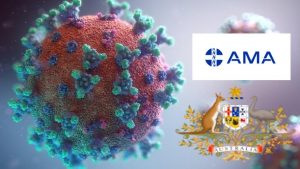
By SAT News Desk
MELBOURNE, 30 December 2021: Just two days before the start of 2022, Australia’s National Cabinet has defined a ‘close contact’ as household or household-like contacts of a confirmed case. Close contacts will be defined, except in exceptional circumstances, as those who usually live with or who have stayed in the same household for more than 4 hours as a case during their infectious period.
But the Australian Medical Association (AMA) feels the definition is narrow. AMA President Dr. Omar Khorshid said narrowing the definition to household contacts will lock in very high transmission rates and accelerate the outbreak of Omicron.
“We will miss so many more cases with this new, more narrow definition of a close contact.
“Anyone catching Omicron in a restaurant or pub for example and who are asymptomatic won’t know they’re infected and could pass the virus on to more vulnerable people.
“The change will help to preserve testing capacity and should limit the number of furloughed health workers, but it will come at the cost of accelerating the outbreak.
“It seems National Cabinet is prepared to bet that a massive Omicron outbreak won’t cause large numbers of hospitalisations. Whilst initial data is encouraging, we expect hospitalizations to rise in coming weeks simply due to the very large number of cases, which will be far larger than the positive tests indicate, due to today’s decision,” Dr Khorshid said.
The close contact definition is related to Australia’s fight against the virus, to implement the government’s test, trace, isolate and quarantine and the vaccine rollout and booster program.
The National Cabinet has for testing and isolation requirements for close contacts and COVID cases agreed that:
· The isolation period for COVID-19 cases will be standardized regardless of vaccination status to a length of 7 days from the date of their positive test.
· Household contacts or household-like contacts, except in exceptional circumstances, must quarantine for 7 days after last exposure to a case regardless of vaccination status and then, subject to a negative Rapid Antigen Test (RAT) on day 6, monitor for symptoms for a further 7 days and repeat testing if symptoms occur.
· Other contacts who have been potentially exposed to a case but who are at lower risk of infection must monitor for symptoms and only need to have a RAT or PCR test if symptoms occur.
· All contacts should wear a mask when outside the home, monitor symptoms and avoid visiting high-risk settings for 14 days following exposure to reduce their risk of transmission to others.
· If RATs are positive, these should be followed by a PCR test to confirm the diagnosis, allow notification and to link individuals into social and medical support. PCR tests are the preferred test for symptomatic individuals.
Close contact arrangements will commence in the Australian Capital Territory, New South Wales, Victoria, Queensland and South Australia from 12.01 am 31 December 2021. South Australia will continue with a 10 day quarantine period for cases and close contacts.
Tasmania will commence arrangements from 1 January 2022. Western Australia and the Northern Territory will advise on the start date for new arrangements.
Since the beginning of the pandemic, there have been 362,690 confirmed cases in Australia and, 2,226 people have died.
Total active cases in Australia have reached over 110,000 cases. However, hospitalization, ICU, and ventilation case numbers remain low and within anticipated capacity. There were 1,481 cases in the hospital, 122 cases in ICU with 51 of those requiring ventilation. These numbers are remaining relatively constant. The majority of cases in ICU and requiring ventilation continue to be amongst people who are unvaccinated.
Australia’s COVID-19 vaccine rollout continues to expand. To date, 42.4 million doses of COVID-19 vaccines have been administered in Australia, including 148,974 in the previous 24 hours.
In a media release, the AMA called for the release of the Australian Health Protection Principal Committee’s (AHPPC) advice and modelling that supports the National Cabinet decision.
“Without the release of AHPPC’s advice, it is very difficult for us to share the Prime Minister’s confidence that this move will assist in keeping Australians safe and healthy.”
The AMA said good isolation practices after exposure to Omicron remain critical in efforts to slow the circulation of Omicron in the community.
“Reducing the period of isolation for those infected and for close contacts to seven days followed by a Rapid Antigen Test (RAT) on day six ahead of a return to work is a logical move.
“Governments should focus on the supply and distribution of RATs with clear instructions on their use, when they are required and what to do with positive and negative results.
“However, the use of RATs for asymptomatic close contacts rather than PCR tests is questionable and PCRs should continue to be used if possible, given their superior accuracy for asymptomatic cases,” Dr. Khorshid said.





